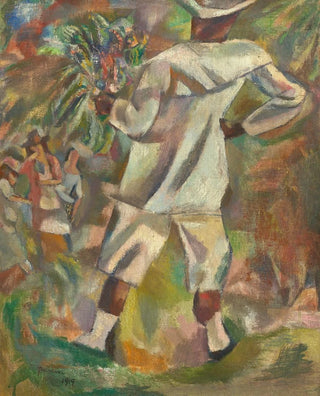Art print | The Sunday Visit - Jules Pascin


View from behind

Frame (optional)
The canvas "La visite du dimanche" by Jules Pascin transports us to the heart of an intimate scene, where everyday life blends with the poetry of human relationships. This artwork, painted in the early 20th century, captures a suspended moment in time, where characters gather in a warm and convivial atmosphere. Pascin, with his unique perspective on city life, manages to evoke a gentle melancholy while celebrating the beauty of human interactions. The art print of this piece allows for appreciation of the fine details and the depth of emotions conveyed, offering a glimpse into the artist's artistic universe.
Style and uniqueness of the work
Jules Pascin's style is characterized by a delicate yet bold approach. In "La visite du dimanche," he uses soft colors and fluid shapes to create an intimate ambiance. The characters, though stylized, are imbued with palpable humanity, each telling a story through their gestures and expressions. The composition, with its sinuous lines and harmonious arrangement, guides the viewer's eye while inviting contemplation. Pascin captures the essence of daily life while infusing it with an almost dreamlike dimension, making this work a true ode to conviviality and the simplicity of human exchanges.
The artist and his influence
Born in 1885 in Sofia, Bulgaria, Jules Pascin was an artist who established himself on the European art scene of the early 20th century. Moving between Paris and New York, he mingled with many influential artists of his time, such as Modigliani and Soutine. His style, which combines European influences with inspirations from Jewish culture, marked the modern painting movement. Pascin is often regarded as a precursor to expressionism, using color and form to express deep emotions. His work, although sometimes tinged with melancholy, is also a celebration of life and the beauty of human relationships. The impact of his work is still felt today, inspiring many contemporary artists to explore themes of intimacy and conviviality.

Matte finish

View from behind

Frame (optional)
The canvas "La visite du dimanche" by Jules Pascin transports us to the heart of an intimate scene, where everyday life blends with the poetry of human relationships. This artwork, painted in the early 20th century, captures a suspended moment in time, where characters gather in a warm and convivial atmosphere. Pascin, with his unique perspective on city life, manages to evoke a gentle melancholy while celebrating the beauty of human interactions. The art print of this piece allows for appreciation of the fine details and the depth of emotions conveyed, offering a glimpse into the artist's artistic universe.
Style and uniqueness of the work
Jules Pascin's style is characterized by a delicate yet bold approach. In "La visite du dimanche," he uses soft colors and fluid shapes to create an intimate ambiance. The characters, though stylized, are imbued with palpable humanity, each telling a story through their gestures and expressions. The composition, with its sinuous lines and harmonious arrangement, guides the viewer's eye while inviting contemplation. Pascin captures the essence of daily life while infusing it with an almost dreamlike dimension, making this work a true ode to conviviality and the simplicity of human exchanges.
The artist and his influence
Born in 1885 in Sofia, Bulgaria, Jules Pascin was an artist who established himself on the European art scene of the early 20th century. Moving between Paris and New York, he mingled with many influential artists of his time, such as Modigliani and Soutine. His style, which combines European influences with inspirations from Jewish culture, marked the modern painting movement. Pascin is often regarded as a precursor to expressionism, using color and form to express deep emotions. His work, although sometimes tinged with melancholy, is also a celebration of life and the beauty of human relationships. The impact of his work is still felt today, inspiring many contemporary artists to explore themes of intimacy and conviviality.






